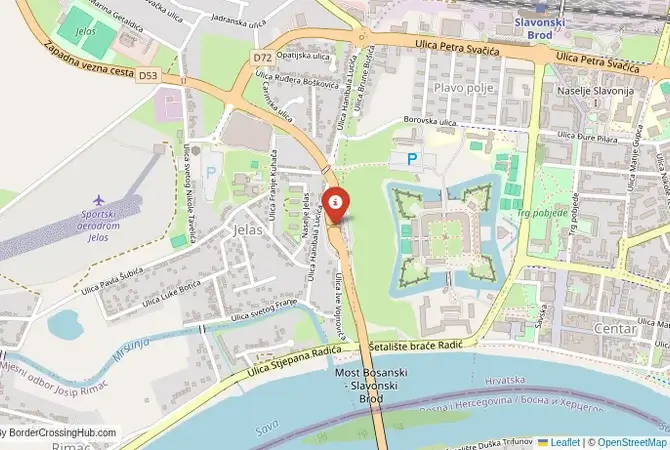
Approximate Border Location
Border Countries
Border Cities
- 🇭🇷Slavonski Brod
- 🇧🇦Svilaj
Wait Times
30-90 min for pedestrians/vehicles
Operating Hours
Open 24 hours
Crossing Types
Pedestrians, vehicles, commercial
Border Type
Land crossing via road
Peak Times
Mornings (7-10 AM), weekends
Daily Crossings
~6000 travelers/vehicles
Currency Exchange
Available near Svilaj (BAM, EUR)
Safety Information
Busy, minimal crime
Languages Spoken
Bosnian/Croatian
Accessibility Features
Ramps, elevators
About Slavonski Brod & Svilaj
A New Bridge on a Historic River
The border crossing connecting the area near Svilaj in Bosnia and Herzegovina with the region of Slavonski Brod in Croatia is a journey across one of the newest and most modern bridges on the Sava River. This is a massive, state-of-the-art motorway checkpoint, a key part of the Pan-European Corridor Vc, which is designed to link Budapest with the Adriatic Sea at the Croatian port of Ploče. Since Croatia is a member of the European Union and the Schengen Area, this is a major external border. To cross here is to experience the most modern vision of European border infrastructure, a seamless passage for those on the motorway, but a meticulous point of control for the EU.
Operational Details
This checkpoint connects the Posavina Canton of Bosnia and Herzegovina with Brod-Posavina County of Croatia. It is a massive, multi-lane motorway crossing, open 24/7. The new bridge and border facility, opened in 2021, were designed to relieve the chronic and severe congestion at the old border crossing, which runs directly through the city centers of Slavonski Brod and Brod. The new crossing is designed for high-speed transit and handles a huge volume of freight and passenger traffic. It is a critical piece of infrastructure for the economies of both countries and for the wider region.
Before Crossing
Crossing borders gets messy sometimes, think political flare-ups or gates shutting fast. Good travel insurance is a must for handling doctor visits, trip disruptions, or security scares. Don’t get caught unprepared. To find a policy that’s got your back, check out reliable plans today for peace of mind.
A History of the Sava River Frontier
The history of this region is the history of the Sava River, which has been a major frontier for centuries. It was the border of the Roman Empire, and later the military frontier between the Habsburg and Ottoman Empires. The city of Slavonski Brod, with its magnificent 18th-century Brod Fortress, was a key defensive point on this frontier. During the Yugoslav era, this was an internal administrative line. The breakup of Yugoslavia and the Bosnian War turned it into a major international border and a frontline. The construction of the new Svilaj bridge is a powerful symbol of the post-war recovery and the new era of European integration.
The Schengen Border Procedure
The border crossing procedure is a rigorous and meticulous process, reflecting its status as a primary entry point into the EU and the Schengen Area. You will first complete exit formalities at the Bosnian checkpoint at Svilaj. After crossing the magnificent new bridge, you will arrive at the Croatian checkpoint for a full EU/Schengen entry inspection by the Croatian Border Police and Customs. You will need a valid passport. National ID cards are only sufficient for EU citizens. Vehicle registration and international insurance (Green Card) are also necessary. As a Schengen entry point, the checks are very thorough, but the modern, multi-lane facility is designed to process traffic as efficiently as possible.
The Surrounding Region: Bosnia and Herzegovina Side
On the Bosnian side, the crossing is in the Posavina region, the fertile plain of the Sava River. The nearby city of Brod (formerly Bosanski Brod) is a major industrial town. The motorway provides a fast connection to the south, towards the capital, Sarajevo, and the region of Herzegovina. The area is the heartland of the Bosnian Croat community.
The Surrounding Region: Croatia Side
On the Croatian side, the crossing is the gateway to the historic region of Slavonia. The city of Slavonski Brod is a major industrial and cultural center, famous for its massive Brod Fortress, one of the best-preserved examples of Habsburg military architecture. The city has a beautiful riverside promenade. The region of Slavonia is known as the breadbasket of Croatia, a land of vast, fertile plains, oak forests, and rich folk traditions. The Lonjsko Polje Nature Park, one of the largest protected wetlands in Europe, is also in this region.
Practical Travel Information
Practical planning for this route is straightforward. The most important thing is to have the required motorway vignettes or toll payments for both countries. Both Croatia and Bosnia and Herzegovina use a toll system for their motorways. The official currencies are the Bosnian Convertible Mark (BAM) in Bosnia and Herzegovina and the Euro (EUR) in Croatia. Large service stations are available on the motorway on both sides of the border. Ensure your vehicle’s Green Card insurance is valid for both countries.
Final Considerations
The Svilaj–Slavonski Brod border crossing is a powerful symbol of modern infrastructure and European integration. The magnificent new bridge is a testament to the future of the region. It offers a fast, efficient, and seamless passage for travelers on the main north-south Balkan corridor. It is a border that is designed for connection, a state-of-the-art gateway that is helping to heal the divisions of the past and to build a more prosperous and integrated future for the entire Sava River region.
See other crossings between Bosnia and Herzegovina and Croatia
See other crossings between Bosnia and Herzegovina and Croatia
No reviews yet.
